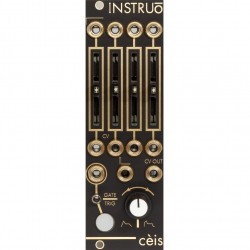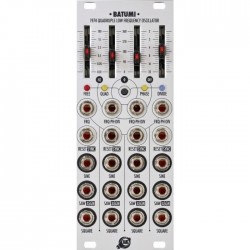Noise Engineering Loquelic Iteritas Eurorack Digital Oscillator Module
Noise Engineering Loquelic Iteritas - Digital Oscillator
The Noise Engineering Loquelic Iteritas is a 10hp digital voltage controlled oscillator with interpretations of three classic synthesis algorithms (VOSIM, Summation Synthesis and Phase Modulation) involving dual pitch control. It creates a huge variety of sounds parameterized by four tone and two pitch controls.
The Loquelic Iteritas is about continuous tone control. Hook any LFO up to any of the four tone control inputs (Morph, Fold, Modulate, Damp).
Other interesting effects can be created by controlling the pitches independently (by default the 1V / 8VA inputs are normalled to each other). For instance, using a Tonnetz Sequent to produce musical intervals produces interesting results.
Interface
• Pitch A - The pitch of oscillator A can be controlled by the 1V / 8VA input and offset by its coarse and fine knobs. The pitch inputs are cross normalled
• Pitch B - The pitch of oscillator B can be controlled by the 1V / 8VA input and offset by its coarse and fine knobs. The pitch inputs are cross normalled
• Damp - is a tone control
• Mod - is a tone control. In all modes it controls the phase modulation between the two pitch oscillators
• Fold - is a tone control. In all modes it controls the threshold of the wavefolding
• Morph - is a tone control. In all modes it controls the waveform of the oscillator continually varying between sine, triangle and saw
• Algorithm - selects which algorithm is used.
• Master - controls the sync of the oscillators. When in the middle position both oscillators are free running. When A is selected oscillator B will sync to oscillator A. When B is selected A will sync to B
• Sync - Sync will reset the state of the oscillators on a rising edge. Used for sync modulation
• Out - Out is the AC coupled audio output
Synthesis Algorithms
• VO - The VO algorithm is roughly based off of the VOSIM algorithm. This algorithm amplitude modulates a carrier by an exponential to create a more complex harmonic structure. The simplest carrier is a sinusoid which produces a spectrum with a Gaussian distribution centered on the carrier. More complicated waveforms produce Gaussians around each harmonic, producing spectra sumilar to comb filtered noise.
• SS - The SS algorithm is a highly modified version of summation synthesis originally developed by James Moorer. The premise comes from a simple mathematical equality between an infinite harmonic series and a relatively easy to compute expression. This equation allows a wide variety of musical spectra to be produced by only two parameters. The Loquelic Iteritas generalises the sinusoidal terms into multi-waveform oscillators: two of these track the two input pitches while the third tracks the difference of the two pitches and adds a wave folder for more harmonics. In the equation oscillator A is the left sinusoidal term in the numerator. Oscillator B is the sinusoidal term in the denominator.
• PM - The PM algorithm is a naive time-domain two-oscillator phase-modulation implementation that combines both oscillators with amplitude modulation.
Specifications
| Width: | 10hp |
| Max Depth: | 25mm |
| Power: | +12V: +58mA |
| -12V: -44mA |





